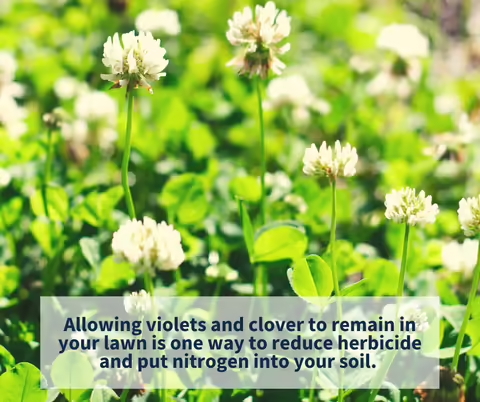by Jan Phipps, Edgar County Master Gardener
In our drive to reduce greenhouse gas emissions, gardeners and homeowners are looking for ways to make lawns less chemical, water, and gas mower dependent. The problem with turfgrass is it lacks biodiversity and provides zero help to wildlife.
One idea being touted is No-Mow May, which turns out to be a rather doubtful concept, causing more problems than solutions. It’s bad for the grass, your mower in June, and friendly neighbor relations.
Fortunately, other choices exist in varying degrees of ease of implementation. The first is easy. Raise your mower height to 3.5 – 4 inches. It is better for the grass, and you may have to mow less often.
Decrease how often you water the lawn, even skipping supplemental water entirely. Turfgrass will go dormant during dry weather but won’t die except in very extreme drought.
Skip the fertilizer. If you are worried about nutrients, top dress with a half-inch of compost, and it will enrich the soil, which in turn will fertilize the lawn.
Skip the herbicide. Leave the violets and especially leave the clover, which is a legume. It is nitrogen-fixing, taking nitrogen out of the air and putting it in the soil. What could be better than a self-fertilizing plant that also comes with a flower? Mowing higher, as previously mentioned, results in fewer blooms being deadheaded. That benefits you, the flower lover, and bees, the pollinators.
Moving on to choices requiring more effort. Reduce the square footage of your lawn, and devote more space to gardens. A perennial garden is more work but is much more interesting to look at and supports wildlife. For less upkeep, plant a garden of native shrubs. Once established, it needs less water, no mowing, and if well mulched, little weeding.
Another choice is outlining your property with a strip of ornamental grass. Choose a large growing variety if you desire privacy and have a way to remove the previous year’s growth in the spring. Or a low-growing variety that softens the line between traditional turf and the ornamental grass. Try prairie dropseed (Sporobolus heterolepsis) in sunny locations and Pennsylvania sedge (Carex pensylvanica) for shady sites. The third choice for a grass-reducing strip is wild strawberry (Fragaria virginiana). It has two additional benefits tolerating some foot traffic and producing small edible fruit.
Now we’ve worked up to the big step – replacing the turfgrass entirely. There are a couple of options for replacement plants. One is cool-season fescue blends that, once established, require mowing only once or twice a season. The second is devoting your entire former lawn to clover. Not only is it a boon to pollinators, but it grows in both sun and semi-shade.
The Illinois Extension Master Gardeners hope you find an option that works for you and your landscape. Call us at 217-465-8585 with your garden or landscape questions.
ABOUT EXTENSION: Illinois Extension leads public outreach for University of Illinois by translating research into action plans that allow Illinois families, businesses, and community leaders to solve problems, make informed decisions, and adapt to changes and opportunities.
